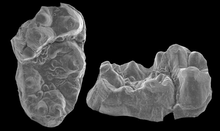| Umayodus | |
|---|---|

| |
| Tooth of Umayodus | |
| Scientific classification | |
| Domain: | Eukaryota |
| Kingdom: | Animalia |
| Phylum: | Chordata |
| Class: | Mammalia |
| Family: | †Didolodontidae |
| Genus: | †Umayodus Gelfo & Sigé, 2011 |
| Species: | †U. raimondi
|
| Binomial name | |
| †Umayodus raimondi Gelfo & Sigé, 2011
| |
Umayodus is an extinct genus of "condylarth" mammal from the late Paleocene or the earliest Eocene.[1] It is a didolodontid which lived in what is now Peru. It is known from the holotype LU3-801, an isolated right third molar, which was found in the Muñani Formation of Laguna Umayo, Peru. It was first named by Javier N. Gelfo and Bernard Sigé in 2011 and the type species is Umayodus raimondi.[2]
Phylogeny
[edit]Cladogram after Gelfo and Sigé, 2011:[2]
References
[edit]- ^ Umayodus at Fossilworks.org
- ^ a b Javier N. Gelfo and Bernard Sigé (2011). "A new didolodontid mammal from the late Paleocene–earliest Eocene of Laguna Umayo, Peru" (PDF). Acta Palaeontologica Polonica. 56 (4): 665–678. doi:10.4202/app.2010.0067.









Well, that’s interesting to know that Psilotum nudum are known as whisk ferns. Psilotum nudum is the commoner species of the two. While the P. flaccidum is a rare species and is found in the tropical islands. Both the species are usually epiphytic in habit and grow upon tree ferns. These species may also be terrestrial and grow in humus or in the crevices of the rocks.
View the detailed Guide of Psilotum nudum: Detailed Study Of Psilotum Nudum (Whisk Fern), Classification, Anatomy, Reproduction